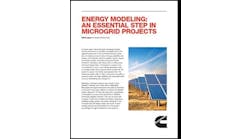Resilient energy – technologies like microgrids that allow us to rebound quickly from a power outage – is evolving from a mere buzzword into a valuable product, sometimes even bumping green energy into second place.
The US Army offers a good example of this change, as explained recently by Michael McGee, executive director of the Army’s Office of Energy Initiatives.
“Our office has evolved,” said McGee, who spoke earlier this month at the Smart Grid Observer’s Microgrid Global Innovation Forum in Washington, D.C. “We have a host of projects that were set up initially to kick start the transition to a clean energy economy. But we are trying to convert those projects to be more focused on a direct resiliency contribution for the Army.”
With strong renewable energy goals, and a lot of open land for training and maneuvers, the Army is a magnet for energy developers. Army land is not just any land. In the eyes of energy developers, it’s ‘want-it-in-my-backyard’ or WIMBY land, a rare find in an era when even solar panels are considered eyesores in some neighborhoods.
A business model to unlock resilient energy
This gives the land value, and the Army is now parlaying that value for energy resiliency with a simple proposition to developers: “We’d like you to site your plant on this land — for something. What you’re doing could be made into the foundation of a microgrid,” McGee said.
The Army supplies the land. In exchange they receive resiliency. Distributed energy projects once conceived for their green value are configured into microgrids. In doing so, the Army provides an example of finding resiliency — and paying for it — with a new business model.
“If our nation is going to address the topic of resiliency and is looking for innovative business models, one of those possible approaches is that there is unlocked value in the current deal structures. There is potential for additional value to be extracted,” he said.
Federation of smaller microgrids
Sometimes it’s a matter refining use of technology to extract the resiliency.
Early microgrids were designed to island an entire facility during an outage. But now the industry is becoming more “flexible, modular and scalable,” said Mark Feasel, Schneider Electric’s vice president for utility segment, smart grid & microgrid.
For a closer look at resilient energy, join us in Chicago May 7-9 at Microgrid 2018
This flexibility offers opportunity to create more customized levels of resiliency, according to Feasel. It becomes possible to analyze each building or load within a campus for its sensitivity to outages and power quality instability. And then, in a “prescriptive and precise way,” create resilience for each.
“So campuses are not necessarily always one big microgrid. Instead they are a federation of smaller microgrids, tied together at the software or cloud level. That drastically reduces the cost of microgrids,” he said, also speaking at the Washington, D.C. event.
Repackaging conventional energy for resilience
In other cases, businesses are re-packaging traditional products to highlight their resiliency benefits. Centrica Business Solutions, for example, now puts under its resilient energy umbrella combined heat and power (CHP), sensors/monitoring/analytics and back-up generation. In the past, Centrica and others marketed these technologies as energy efficiency or smart energy.
Companies are adopting the “resilient energy” phrase because their customers see its value. In a survey of 365 decision-makers across a range of industries, Centrica found that 69 percent see the cost of building an energy resilience strategy as far less than the cost of an energy-related failure, according to Centrica’s recently released ‘U.S. Resilience Report.’
“It is hard to overestimate the importance of energy resilience,” says the report. “It supports future-proofing strategies to reduce dependency on single-source energy supplies. It encourages revised maintenance approaches to effectively reduce downtime. It minimizes commercial risk by adding cost-effective onsite energy-producing capabilities.”
Battle over the soul of the product
Resilient energy is clearly the new, new thing for the industry. Any question of that was put to rest during a recent battle for the soul of the product before the Federal Energy Regulatory Commission (FERC). U.S. Energy Secretary Rick Perry last year attempted to paint incentives for baseload power, including coal-fired plants, as a means to bolster resilient energy. The term resilient energy usually applies to microgrids, distributed energy resources and grid modernization efforts. Industry stakeholders appear intent on keeping it that way. They responded to Perry’s proposal with vigor, filing more than 1,500 comments. A sizable portion protested awarding coal the moniker of resilient energy.
FERC, too, ultimately disagreed with Perry (RM18-1-000). But the dispute continues over exactly how to define resilient energy. FERC now is exploring the issue in another proceeding that examines the resilience of the bulk power system (AD18-7-000), with comments from industry participants due May 9.
The Bipartisan Policy Center, in its recent paper, ‘Power System Resilience: A Primer, ‘ summed up the elevation of resilient energy aptly. “Regulatory and real-world events have pushed power sector resilience into the policy world limelight. Important work is underway at federal agencies, market operators, and other organizations to better define, measure, and assess power sector resilience.”
Be it because of the most recent snowstorm, hurricane, or threat of cyberattack, resilient energy is on the rise, imbued already within distributed energy, just waiting to be unlocked through creative contracting, technology configurations and packaging.
Read more original content about resilient energy. Subscribe to the free Microgrid Knowledge newsletter.






